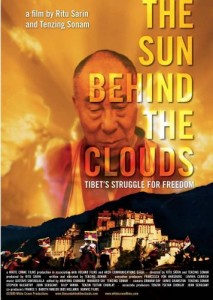To this jaded New Yorker, the recent political brouhaha surrounding Tibetan filmmakers Tenzing Sonam and Ritu Sarin’s “The Sun Behind The Clouds: Tibet’s Struggle for Freedom” seems much ado about nothing. The documentary, shot throughout 2008 leading up to the Beijing Olympics and structured around the biggest uprising in that Chinese-controlled country since it lost its independence in 1959, was the reason the state-run China Film Group pulled its feature “City of Life and Death” from the Palm Springs International Film Festival. (A subsequent screening of that movie here at NYC’s Film Forum, which premieres “The Sun Behind The Clouds” on March 31st, was also cancelled.)
That the Chinese don’t want to be included in any festival that also screens a pro-Tibet doc is simply as childish as that same government’s naïve belief that all their Tibetan woes will vanish once the Dalai Lama dies and a state-approved lama takes his place. It’s as silly as Americans once magically thinking that the capture of Osama bin Laden would quell Muslim hatred of us.
Of course, there’s no such thing as bad publicity, and a modest, 79-minute film – mostly made up of straightforward talking head interviews with the Dalai Lama and assorted activists, alternated with footage of protest marches caught on the fly – needs all the profile raising it can get. Ironically, though the doc clearly indicts Chinese policy towards Tibet, it is more focused on the rift inside the Tibetan community itself – between those who will settle for nothing less than independence and those who believe wholeheartedly in the Dalai Lama’s “Middle Way Approach,” forsaking independence for true autonomy.
Then again, this is all merely a philosophical debate between members of the same side, with no real world effect since the Chinese steadfastly refuse to negotiate.
And why should they? Like the USSR during its heyday, China knows no country will seriously challenge its right to run an economically strategic stronghold like Tibet. One historian smartly points out that most protesting inside Tibet are under-50 and grew up under Chinese rule, never knowing independence in the first place. To them this is an economic issue – i.e., Chinese immigrants come into the country, exploiting its natural resources and displacing its workers – above an idealistic one.
In fact, the closer one looks at Tibet the more it resembles just another casualty in an “imperialist cultural invasion” (as the China-residing, Tibetan exile writer Woeser puts it) that has repeated itself around the world since time began. Indeed, the historical parallels are so striking one only wishes the filmmakers had expanded their outlook as far as the Dalai Lama himself does.
The film leaves the audience with more questions – that could have been probed far deeper – than answers. Is the Dalai Lama’s “Middle Way Approach,” derived from the Buddhist tenet of always searching for the middle ground between the two extremes, simultaneously a form of WWII-type appeasement to a dictatorial regime? Is this compromise position also an attempt to keep a Tibetan genocide at bay?
Are the anti-Buddhist Chinese really all that different from the anti-Catholic Soviets – both knowing that religion is the soil that fertilizes uprisings? And if so, how did the pope manage to balance nationalism with nonviolence while the Dalai Lama seems forever to be caught in its crossfire?
Indeed, as leader of both the Tibetan community and the worldwide Buddhist community, the Dalai Lama’s nationalism is oftentimes at odds with his spiritualism – yet he’s comfortable with this “conflict of interest” (which only seems to grate upon the Chinese who can’t figure out which side he’s batting for at any given time).
Why didn’t the filmmakers thoroughly address any of these issues, one wonders, especially since they had unprecedented access to his Holiness himself? In the end “The Sun Behind The Clouds: Tibet’s Struggle for Freedom” may be controversial, but it’s also a lost opportunity to cast light into the darkest recesses of humankind.


It is just another Tibetan propaganda film like Chinese have the same propaganda film.
Nobody knows that Dalai Lama is a God king raised by aristocrat family. He never even cooked one meal for himself. He was raised like a King. And people think he has done a lot for humanity. This is a big joke in history. People are blinded by Hollywood movie.
I can see why, as a non Tibetan, you would rate the movie with only 2 stars. Being Tibetan, it speaks a lot more to me. This documentary may not win an Oscar but it’s a much needed movie- Tibetans needs to see that the divisions we’re creating amongst ourselves will break us and bring an end to the momentum we had going. Tibetans, both inside and outside Tibet, need to see this movie. Bhod Gyalo! Bhod Rangzen!
Tsering come out from under your pseudo-tibetan handle. You’re chinese. You know it, and we know it. Why the masquerade?